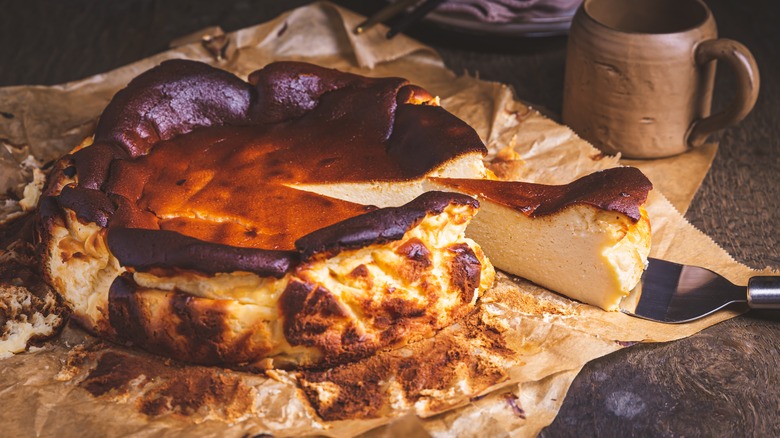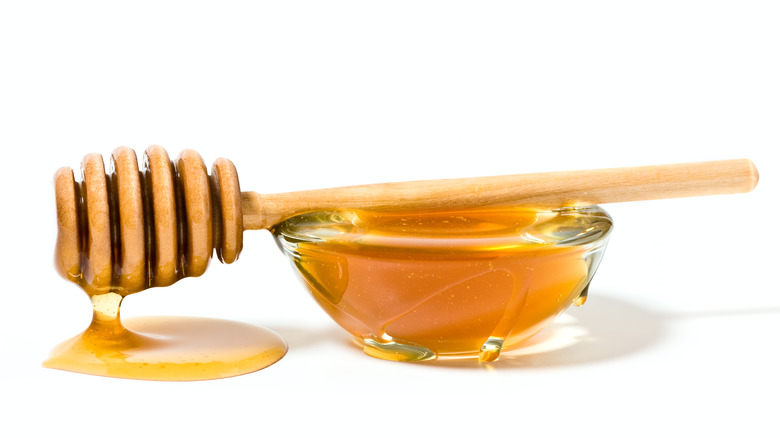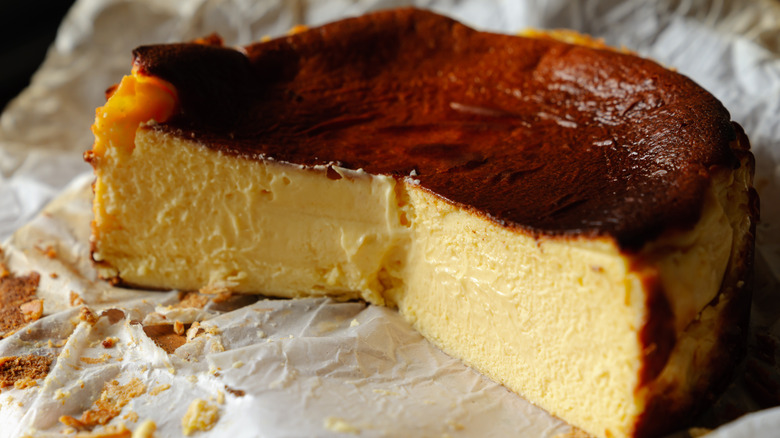Honey Is The MVP For Perfect Basque Cheesecake
The popularity of Basque cheesecake, sometimes called burnt Basque cheesecake, has exploded in recent years. The power of social media has brought it to the attention of the masses in the digital age but, in reality, the exceptionally caramelized dessert (that goes way beyond crème brûlée) was developed in the late 1980s. There are a few things that set this confection apart from the classic New York style cheesecake, including the noticeable lack of ingredients (there are only five), the jiggly center, and the top of the cake, which is intentionally blackened.
The traditional recipe for Basque cheesecake uses granulated sugar as the sweetener and as the vehicle for its dark top, but sugar tends to caramelize slowly, and sometimes home cooks end up overcooking the cheesecake in order to get the top deeply colored. This affects the center of the cheesecake, which is supposed to remain loose, like flan. Substituting some of the sugar with honey, however, will result in quicker caramelization and that desired soft center.
The appearance of an evenly charred Basque cheesecake top made with sugar is often the result of baking but then shifting it to the broiler to get the desired color on the top. Yet, when using honey, you'll get the color you're looking for without the use of the broiler, which we all know can ruin a dish if you walk away for a few seconds too long.
Honey caramelizes quicker than sugar
Basque cheesecake also takes an unusual approach in its baking method. While traditional cheesecakes are typically baked low and slow with the aid of a water bath to gently cook the cake to a creamy consistency (and avoid cracking), the former is blasted with heat. New York cheesecakes need a long time in the oven to fully cook while the Basque counterpart is often done in under an hour to keep the center nice and sticky.
This is again where the honey swap comes in handy. The sucrose in granulated sugar caramelizes at 320 degrees Fahrenheit, but the fructose in honey reaches the caramel stage at 230 degrees Fahrenheit, so basically, using honey in the recipe will give you a dark top much quicker than sugar.
The trick though is to not substitute all of the sugar in a Basque cheesecake recipe with honey as the extra moisture could affect the recipe; instead, sub in no more than half of the sugar content the recipe calls for. Doing so will give you an evenly caramelized top, an interesting flavor (depending on the type of honey you use), and that coveted creamy center.
Basque cheesecake has been around for over 40 years
The original Basque burnt cheesecake was developed in a restaurant called La Viña in San Sebastian, Spain, in the heart of Basque country in the 1980s. Santi Rivera, the son and nephew of the family who originally opened La Viña, loved to experiment in the kitchen and his cheesecake was one of the creations he made from time to time, influenced by his travels.
In the 1980s, cream cheese had just recently come to Spain and was the basis of the confection. More and more people began to request the cake, but its popularity really took off in the early 2000s when tourists began taking food tours of the city, stopping at La Viña where they were introduced to the unusual dessert.
There is no crust in a Basque cheesecake, which allows the thick, eggy filling to be the star. Between this, the too-hot temperature it's cooked at, and the noticeable "unset" center, the sweet treat is the antithesis of what most people know as cheesecake, but somehow, it works. Several other eateries in Basque country now offer the dessert as well, not to mention a growing number of locations in the United States that make the cake as well. Of course, with its short ingredient list and a founder who never minded sharing the recipe, home cooks can successfully make their own, too.



